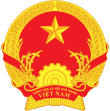Viet Nam requests U.S. to cancel reciprocal tariff
VGP - Minister of Industry and Trade Nguyen Hong Dien sent a diplomatic note requesting the U.S. to cancel the imposition of 46 percent tariff on imports from Viet Nam and allow more time for a constructive dialogue.

Director of the Ministry of Industry and Trade (MoIT)'s Department of Foreign Market Development Ta Hoang Linh
Director of the Ministry of Industry and Trade (MoIT)'s Department of Foreign Market Development Ta Hoang Linh made the announcement on April 3 in Ha Noi at a press briefing following the U.S. Administration's announcement of reciprocal tariffs on 180 trading partners.
He revealed that the MoIT would promptly arrange a ministerial phone call and technical talks with the Office of the U.S. Trade Representative (USTR).
Viet Nam's exports to the U.S. mainly compete with goods from third countries, not with U.S.-made products, thereby benefiting American consumers with more affordable options.
Ta said that the most-favored-nation (MFN) tariff rates Viet Nam is imposing on imports from the U.S. average 9.4 percent. Therefore, the tariff rate of up to 46 percent on Vietnamese goods lacks a scientific basis and is considered unfair, failing to reflect Viet Nam's goodwill and efforts to address the trade imbalance between the two countries in recent years.
The Vietnamese Government, ministries, and agencies have taken proactive steps to address various challenges faced by U.S. companies operating in Viet Nam. These include a decree reducing MFN tariff rates for 13 categories of U.S. goods. Additionally, a large number of U.S. investment projects have had their difficulties resolved, he concluded.
The U.S. Administration's decision to levy a 46-percent tariff on Vietnamese goods places Viet Nam among the nations facing the highest tariff rates, surpassing those imposed on Viet Nam’s competitors in the U.S. market like Thailand (36 percent), Pakistan (29 percent), and the Philippines (17 percent).
Viet Nam is also subject to a much higher rate than that of Bangladesh (37 percent), China (34 percent), Indonesia (32 percent), India (26 percent), Malaysia and Japan (both 24 percent), and the EU (20 percent)./.

